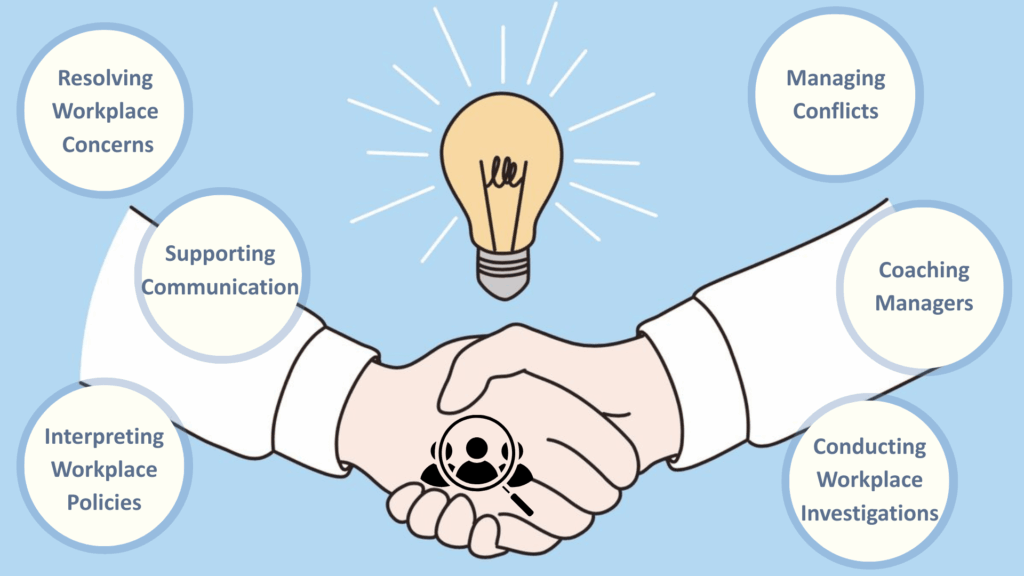The 12-hour shift schedule has become standard practice across many industries.
From hospitals to factories, millions of workers now clock in for these extended shifts instead of traditional 8-hour days.
This schedule format offers benefits like more days off and higher pay potential.
It also brings challenges, including fatigue and work-life balance issues. Some workers thrive on this schedule, while others struggle to adapt.
If you’re considering a job with 12-hour shifts, you need the full picture.
It covers everything about 12-hour shift schedules, the pros, cons, and drawbacks. It might work for your situation.
What Defines a 12-Hour Shift Schedule?
A 12-hour shift schedule means working 12 consecutive hours per shift instead of the standard 8-hour day.
Workers typically work fewer days per week but put in longer hours each day.
This schedule is common in healthcare, manufacturing, emergency services, and security. Industries that need 24/7 coverage often use this format for better staffing efficiency.
Many hospitals rely on this system to ensure continuous patient care while giving nurses extended time off between shifts.
Read our guide on full-time job hours and the benefits you should expect.
Common 12-Hour Shift Schedule Examples
Several popular 12-hour shift patterns exist, each offering different work-life balance benefits.
These schedules help you maximize your 12-hour workday while getting more time off:
2-2-3 Schedule
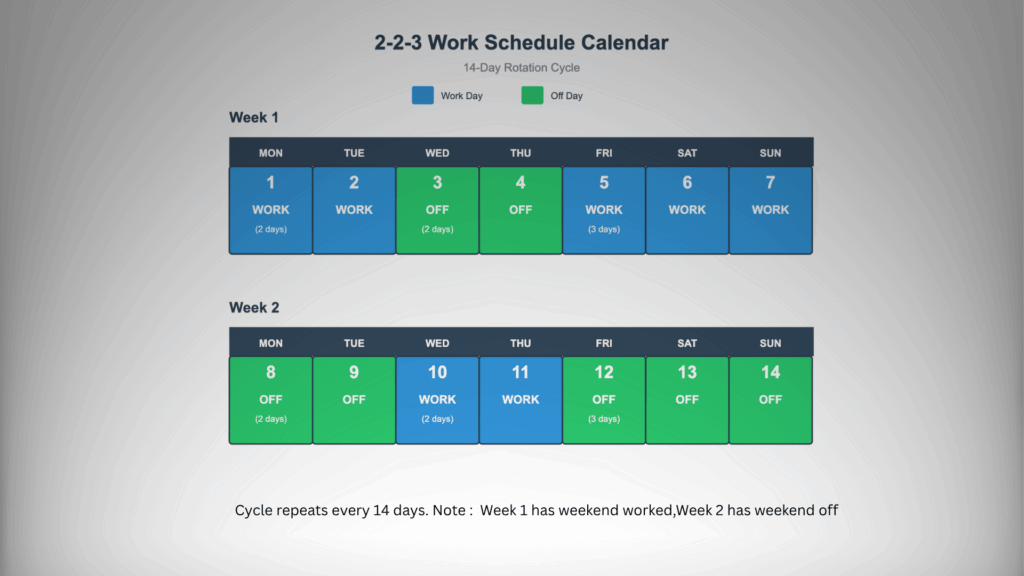
The 2-2-3 schedule follows a 14-day cycle: work two days, off two days, work three days, off two days, then work two days and take three days off.
This rotation ensures employees get every other weekend off, offering a balance between extended work periods and predictable rest.
It is popular in industries requiring continuous coverage, as it maintains consistent staffing while giving employees significant time for personal and family activities.
DuPont Schedule
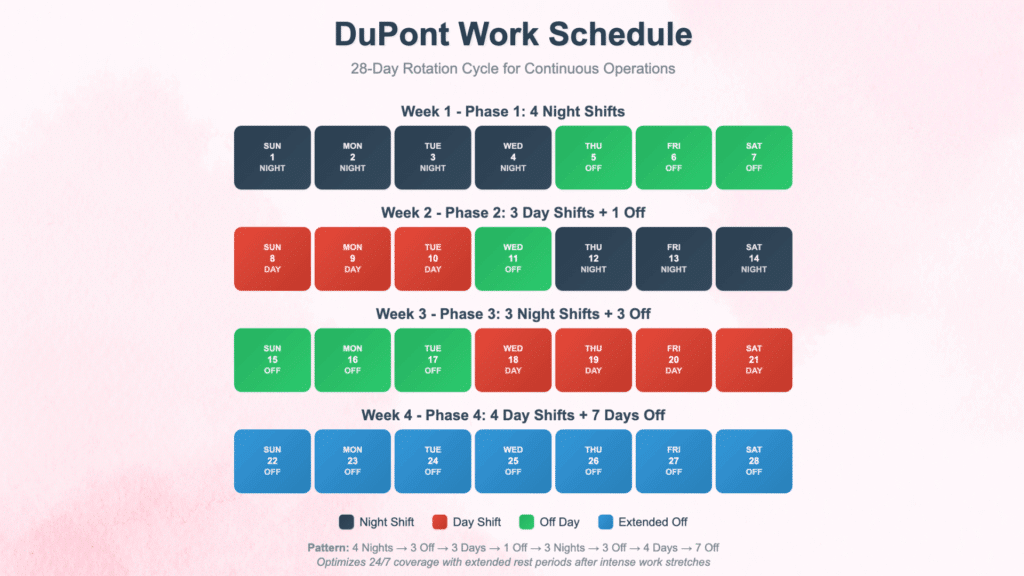
The DuPont schedule is a 28-day rotation designed for continuous operations.
Employees work four night shifts, followed by three days off, then three day shifts with one day off, another set of three night shifts, three days off, four day shifts, and finally seven consecutive days off.
This schedule optimizes coverage for 24/7 operations while providing longer rest periods after intense work stretches.
It requires careful planning but can significantly improve employee work-life balance during off periods.
Panama Schedule
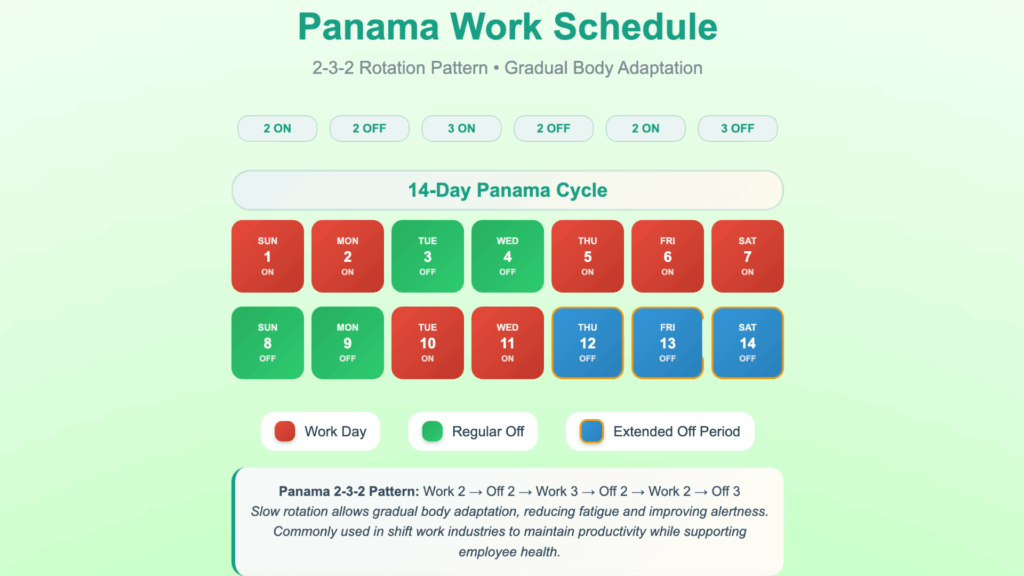
The Panama schedule follows a 2-3-2 rotation: two days on, two off, three days on, two off, two days on, and three days off.
This slow rotation pattern allows the body to adapt gradually to work and rest cycles, reducing fatigue and improving alertness.
It is commonly used in industries with shift work and provides a structured approach to maintain productivity while supporting employee health.
4-On, 4-Off Schedule
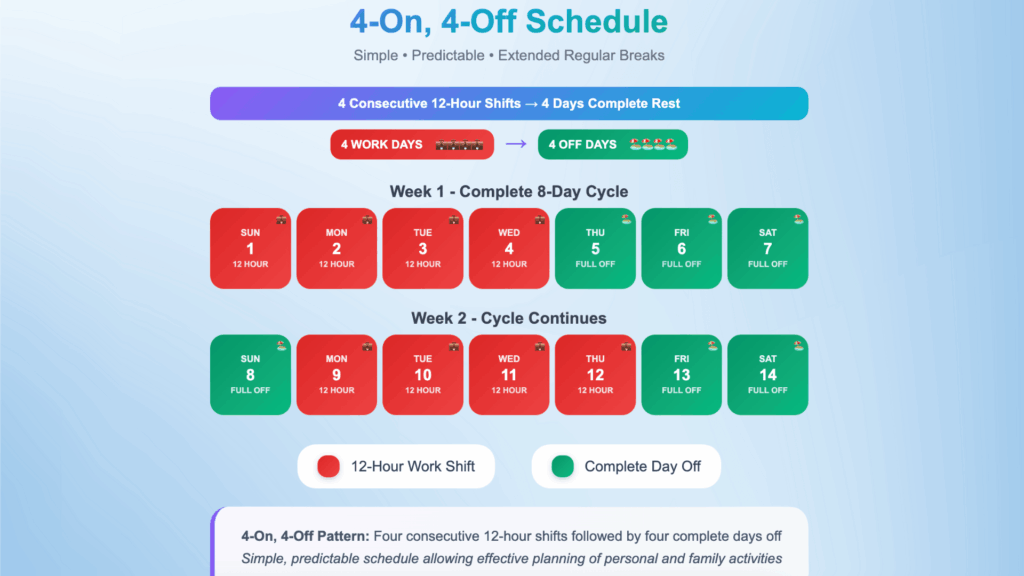
The 4-On, 4-Off schedule consists of four consecutive 12-hour shifts followed by four days off.
This pattern is simple, predictable, and provides extended, regular breaks every week, allowing employees to plan personal and family activities effectively.
It is often favored in operations requiring consistent coverage with minimal schedule complexity, offering a balance between intensive work periods and sufficient recovery time.
What to Expect During a 12 Hour Work Day?
Understanding what to expect during your 12-hour workday helps you prepare for these extended shifts.
| Time Period | What to Expect | Energy Level |
|---|---|---|
| Hours 1-4 | High energy and focus, good productivity | High |
| Hours 5-7 | Steady performance, first break, and meal period | Medium-High |
| Hours 8-10 | Energy dip, most challenging period, fatigue sets in | Low |
| Hours 11-12 | Final push, anticipation of shift end | Medium |
Read about: Why Safety Is Important in the Workplace?
Advantages of a 12-Hour Shift Schedule
Working 12-hour shifts offers several compelling benefits that attract many employees:
- Extended Time Off- Longer weekends with fewer workdays per week.
- Higher Pay Potential- Overtime or shift differentials increase earnings.
- Better Work Coverage- Fewer shift changes improve team communication and project continuity.
- Reduced Commuting Costs- Less travel saves time, money, and stress.
Disadvantages of a 12-Hour Shift Schedule
While 12-hour shifts offer benefits, they also come with significant challenges you should consider:
- Physical and Mental Fatigue- Long 12-hour shifts reduce focus and increase errors.
- Health Risks- Extended hours disturb sleep and meals, raising stress, weight gain, and sleep issues.
- Work-Life Balance- Long shifts plus commute leave little time for family or personal activities.
- Social Isolation- Irregular schedules make it hard to maintain friendships and social connections.
Is a 12-Hour Shift Schedule Right for You?
If a 12-hour shift schedule fits your lifestyle, it requires honest self-assessment.
Consider your personal health first. If you struggle with fatigue during 8-hour days, longer shifts might prove challenging. Family commitments matter too.
Parents with young children often find 12-hour shifts difficult, though some prefer the extended days off.
Financial benefits like overtime pay can boost income significantly. Before committing, consider a trial period to see how your body adapts.
Alternatives to Working 12-Hour Shifts
If a 12-hour workday doesn’t suit your needs, consider these scheduling options that might better fit your lifestyle:
| Schedule Type | Description | Best For |
|---|---|---|
| Traditional 8-Hour Shifts | Standard Monday-Friday schedule with predictable hours and regular breaks | People who prefer consistent routines and normal sleep patterns |
| Flexible Scheduling | Work four 10-hour days or choose flexible start times | Better work-life balance while maintaining full-time hours |
| Rotating Shifts | Alternate between morning, afternoon, and night shifts | Those who want variety and a shared burden of less desirable hours |
Got a late paycheck? Learn your rights here!
Conclusion
The 12-hour shift schedule offers extended time off and higher pay but comes with fatigue and work-life balance challenges.
Your personal health, family commitments, and financial goals should guide your decision.
Some people thrive on longer shifts and enjoy extended breaks, while others perform better with traditional schedules.
Consider a trial period to test how your body adapts before making permanent changes.
What’s your experience with different work schedules?
Share your thoughts in the comments below and help others make informed decisions.
Frequently Asked Questions
Is the 7 AM to 3 PM Shift Considered First Shift?
Yes, the 7-3 shift is typically considered the first shift, usually starting in the morning and ending in the afternoon.
Which Is the Most Difficult Shift to Work?
The third shift (overnight shift) is often considered the most difficult due to its impact on sleep, health, and social life.
Is the 3rd Shift Unhealthy?
Yes, the third shift can be unhealthy due to disrupted sleep patterns, increased stress, and a higher risk of certain health conditions like heart disease and diabetes.









